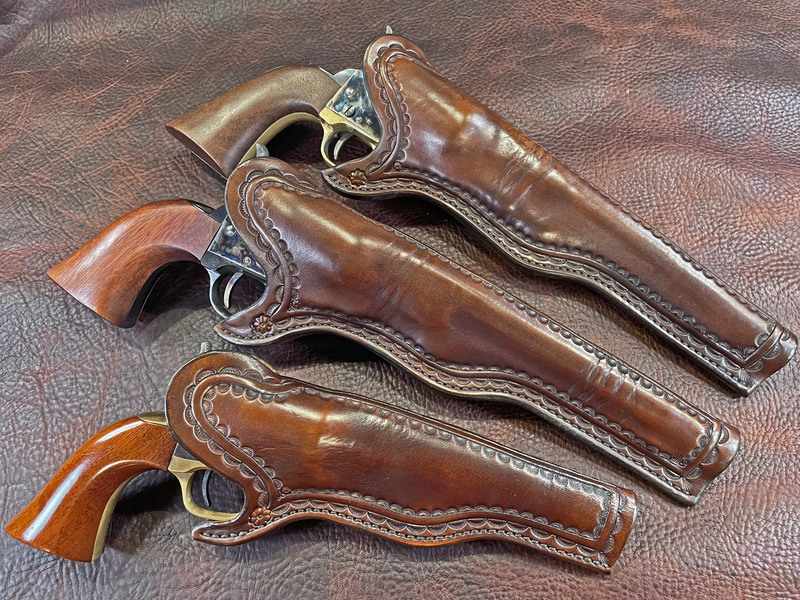You are using an out of date browser. It may not display this or other websites correctly.
You should upgrade or use an alternative browser.
You should upgrade or use an alternative browser.
Holsters and belt
- Thread starter Red Owl
- Start date

Help Support Muzzleloading Forum:
This site may earn a commission from merchant affiliate
links, including eBay, Amazon, and others.
I've always assumed the traditional flap holster was most commonly used due to the military and volume during and after the Civil War but never really thought about it. Looking forward to seeing what others say.This doesn't get discussed too much but for a pair of percussion revolvers, assuming long John holsters are used- what kind or kinds of belts were historically common?
Attachments
- Joined
- Jul 24, 2018
- Messages
- 4,497
- Reaction score
- 5,650
The Slim Jim originally started from people cutting flaps off of the then dirt cheap and widely available military surplus holsters.This doesn't get discussed too much but for a pair of percussion revolvers, assuming long John holsters are used- what kind or kinds of belts were historically common?
I don't think trouser belts were a thing yet, so they'd just carry the gun on a leather gun or work belt, probably nothing fancy or tooled for the average guy, just a standard leather buckle belt
Military surplus belts were probably all over the place too, so most likely also used a lot, probably with a civilian type buckle on it
The California "Slim Jim" pattern was developed in the early 1850's, long before there were any surplus military holsters. While the later Mexican loop pattern was mostly a product of the cartridge era. Before cartridges, belts were much narrower, much like the Civil War era officer's belt at around 2".


- Joined
- Jul 24, 2018
- Messages
- 4,497
- Reaction score
- 5,650
I see how the Slim Jim protects the capsThe California "Slim Jim" pattern was developed in the early 1850's, long before there were any surplus military holsters. While the later Mexican loop pattern was mostly a product of the cartridge era. Before cartridges, belts were much narrower, much like the Civil War era officer's belt at around 2".

Johnny Tremain
Silversmith in training
Been looking into a cross draw non flap holster. The Jim seems to be what I was looking for.
I normally tuck it in my belt.
I normally tuck it in my belt.
The slim jim holsters followed the revolver's contours which the military holster did not do. Slim jims with a half flap were also popular but your question was about belts. The holster would have been carried on a belt of about 2" width max. It could have been plain with a roller buckle or tooled with a fancy buckle. It would depend on the owners disposable income.
Attachments
my slim jim. I had my cobbler add a snap over the hammer. these rigs do not have a transfer bar and are really unsafe to carry without some way to secure the hammer. flap is safest and this strap is a compromise.


user 48702
Richard Turner
- Joined
- Sep 17, 2020
- Messages
- 1,142
- Reaction score
- 2,802
You need to get or read a copy of "Packing Iron" Gunleather of the Frontier West. They have 20 to 30 fine color examples of open top slim jim style holsters and variations of belts and none were made from modified military holsters. There were more than a few saddlemakers who specialized in making this style holster prior to the Great War. Also, a visit to the Buffalo Bill Museum and the NRA Museum display some great examples as well as the Gene Autry's Museum in LA, CA.The Slim Jim originally started from people cutting flaps off of the then dirt cheap and widely available military surplus holsters.
I don't think trouser belts were a thing yet, so they'd just carry the gun on a leather gun or work belt, probably nothing fancy or tooled for the average guy, just a standard leather buckle belt
Military surplus belts were probably all over the place too, so most likely also used a lot, probably with a civilian type buckle on it
Last edited:
- Joined
- Jul 24, 2018
- Messages
- 4,497
- Reaction score
- 5,650
I will have to get itYou need to get or read a copy of "Packing Iron" Gunleather of the Frontier West. They have 20 to 30 fine color examples of open top slim jim style holsters and variations of belts and none were made from modified military holsters. There were more than a few saddlemakers who specialized in making this style holster prior to the Great War. Also, a visit to the Buffalo Bill Museum and the NRA Museum display some great examples as well as the Gene Autry's Museum in LA, CA.
user 48702
Richard Turner
- Joined
- Sep 17, 2020
- Messages
- 1,142
- Reaction score
- 2,802
I think they are pretty pricey these days, first printed in 1993, and Richard C. Rattenbury is the author. My copy is at the shop, but here is what the cover looks like, a framed poster in my den.I will have to get it

Similar threads
- Replies
- 6
- Views
- 599
- Replies
- 23
- Views
- 1K
- Locked
- Replies
- 3
- Views
- 555
- Replies
- 17
- Views
- 823
- Replies
- 0
- Views
- 378






